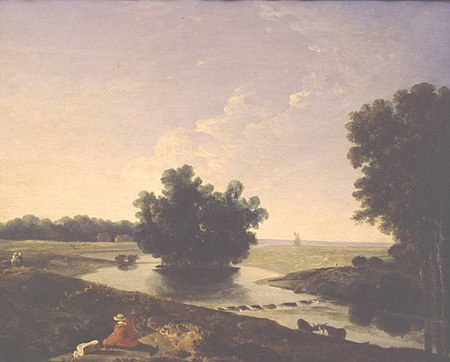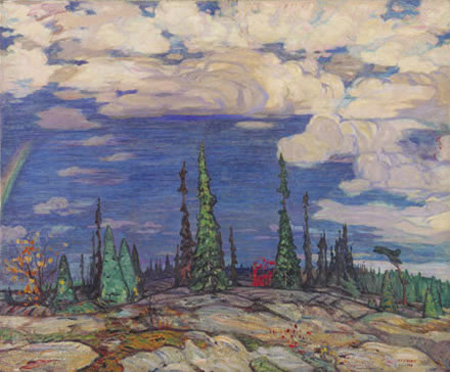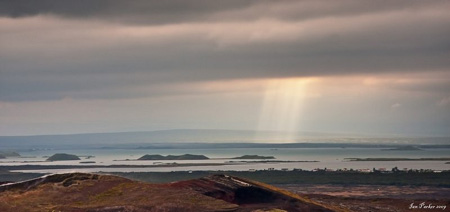
Rackstraw Downes Mixed Use Field on Texas Coast, 1987, oil on canvas on board, 11 x 58 inches
As someone soon to be facing how to paint a large desert sky spread across a large desert panorama, I’m circling the question of the possibilities available.* The Goldwell Foundation, where I’ll be painting,locates itself physically near Beatty, Nevada, on the northwest region of the Basin and Range country, 8 miles and one mountain range from Death Valley. I’ve done lots of small studies there. Now I’m contemplating the Big One. Desultorily contemplating…..
I have no theories, only pictures.

Turner Landscape with Distant River and Bay
c. 1840-50; Oil on canvas, 94 x 124 cm

Richard Wilson, On Hounslow Heath, 14 . 5″ x 18″, circa 1770

Turner Sun Setting over a Lake
c. 1840, Oil on canvas, 91 x 122.5 cm

John Constable, The Stour Valley from Highham, c. 1804, Oil on canvas

A.Y. Jackson Terre Sauvage, 1913, oil on canvas, 50 x 60″

Lawren Harris, From the North Shore, Lake Superior,1923 or 1927 Oil on Canvas

Emily Carr (cropped by Underwood) Vanquished, 1931, original: 92 x 129 cnm
And then there are the photographers. I got waylaid, distracted, stopped and muddled by the plethora, so I only include two. A number so small as to be silly. I suspect that Steve could provide me with innumerable sky photos just by turning on his computer —

Roland Lee, Yucca Skies Chosen for its desert reference.

Ian Parker, Light Beam (Iceland), chosen for its stylized photography — the illusion of a painting.

“Morgan” from a student work, on a London Educational web site, chosen because it’s so eccentric.
There are thousands, possibly millions, more paintings and photographs of skies, ranging from the most subtle to the most outlandish, from the dabs of the impressionists through the stylish swerves of the Candians to the symbols of students. Photographers love skies; ordinary people love skies. Everyone has opinions about skies. Even the desert has skies, skies that can be far more interesting than the skies that I love in Portland Oregon. (Well, sometimes I love them; sometimes they are just gray).
I think the sky I’m envisioning will have to both blend and change, across the 25 or so feet of the panorama. I think it will have to signify different things — time of day, weather, potentials. I think it will have to be interesting, but void-like. It will have to signify “sky” but be one with the desert below. It will have to be interesting. It will have to say distance and potential and sublimity. Small challenges.
It’s less than a month before I get to work on this itch, this desert panorama, and and so this is one way to spend the intervening weeks.
*For those not following my obsessions, I will return to the Red Barn at the Goldwell Foundation, at the head of the Amargosa Plain, to work on three to five (?) 4 x 5′ vertically oriented canvases, arranged in a panorama, in November and early December. I will be keeping a journal of that time on another blog. Stay tuned.

June,
The sky in the Emily Carr picture looks composed of crystals, very much the opposite of Turner’s soft depiction.
I spent the weekend photographing clouds. Sun setting over the Hudson River. Interesting cloud layers snapped from an airplane flying back to Michigan. I do share your interest.
Hi Birgit,
I thought of you as I was looking at the Turner images on the web. Did you get to see some in real life? What did you learn from them?
Cloud layers are really something, because you often are flying above them rather than seeing them from below. That view confuses my brain — I love it.
If anyone has any cloud theories or cloud painting tips, particularly in light of the long format I’m envisioning, please bring it forth. I’ve read meteorlogical treatises and lists (with illustrations) of kinds of clouds and even John Carlson on where the shadows go — but as usual, I want more….. or different…….
June,
From Book of Clouds by Chloe Aridjis
…Oh, I was quite young…Nine, I think. I used to pretend to keep a cloud garden, which I fed daily. And when the clouds were big and strong I would unfasten them from their roots and let them drift upwards, into the sky, and…
…Well, I would unfasten them, but only after months of nurture, during which they prepared for the big ascension, the main event in their lives. Aerial histories were recounted, wind currents and nephological formations explained, navigational skill honed…
…Once in the sky, however, the cloud had to accept that its life would be ephemeral. At best it’d become a rain-laden nimbus and depart in a thunderstorm – and, to everyone but dreamers and metereologists, it would be indistinguishable from its colleagues…
…And well, you know, a whole existence might be reduced to drifting upwards to join a cloud rack, merging with the slow-moving flock and then, in a matter of minutes, without having left any imprint on the world, returning to the atmosphere the elements it had been lent….
June,
I appreciate the Turners. I never made it to the Met, not wanting to see its exhibit of Watteau. Instead, I went to MOMA and some other wonderful exhibition about which I am writing a post.
Guys:
June, as I have said – and I’m sure to repeat – that’s one mighty project upon which you are due to embark. The whole thing falls into place if your hosts at Beatty offer to accept your panorama, so to exhibit it in some appropriate manner. Otherwise, please oblige us who remain with a photo album of you and Jer endeavoring to stuff your mighty accomplishment into the limited confines of your car. Maybe you might arrange the painting(s) in front of the car so that it appears that you are driving into the space it depicts. A photo from the front seat…
As for the sky, Frederic Remington came to mind. But then, upon pulling some up, it would seem that F.R. tended to make short shrift of his skies, treating them as featureless scrims. So much for Fred. As for your own skies I would think that you are free to concoct at will. If I remember, Jer has a panorama feature on his camera. You may wish to stay away from photo-assisted depiction, but maybe it could capture some ephemera for future reference. Have you ever tried painting a mirage? Has to be tough.
Turner would have had a hard time painting Death Valley.
Birgit, the Book of Clouds sounds fascinating. And I guess one can’t complain about substituting MOMA for the Met. Or at least this one in Portland Oregon, wouldn’t.
Jay, I have sorted out the logistics, figured out the spaces, and think that if Jer drives from the hood of the Honda, we’ll get the paintings home just fine. I have also factored in the thought that they won’t be worth bringing home, in which case, I know where the Beatty dump is.
I have a better word the “void” now: I shall speak henceforth of “un-oriented” space. I stole it from a book called Space and Place by Yi-Fu-Tuan, and he says it resembles something like astronomical cycles, which aren’t “going anywhere” far more than it resembles Interstate 80 as it zooms to Reno and the far Sierras. Oriented space faces front and is linear; unoriented space seems to be no-place or at least always to return to the same place.
Well, it’s better than “the void” which might have connotations to be avoided.
June:
Jer has driven from the hood I take it. Just make sure that he wears a lot of sun screen and he might want to don one of those bug leather bra things that were all the rage on cars yea ago.
Hard to imagine someone named Yi-Fu-Tuan as un-oriented in his thinking. Rt. 80 also zooms from the Vicinity of Lock Haven to the far Poconos if my roadology serves me.
Jay,
Route 80 served as a major touchstone for our goal-oriented journeys over the years that we traveled cross country a lot, although I-70 was more important in later years. A much more interesting (from a certain point of view) to go east to west across Nevada is US Route 50, called, pretty accurately, the loneliest highway in the US. It traverses the entire Basin and Range, east to west (and back again, if you are really fascinated) and when we drove it, sometime in the 70’s, you could drive for hours without seeing another car. I-80, alas is just another boring boring boring interstate.
Our road to Beatty, god willin’ and no blizzards arise, will take us south from eastern Oregon on US routes, through Winnemucca, and then via 80 west for a tiny bi before turning south again on highway 95, which goes directly to Beatty.
Route 80 is storied as one of the last of the interstates to be finished, because they couldn’t get through the Pennsylvania Mountains (yep, Lock Haven was part of it) where my home territory existed. Once it was finished, and before I-80 became a horror of trucks and spilled exhaust fumes, my parents would take it for their Sunday drives (those were the days!). It opened up territory that they had known their entire lives but never seen from that angle before and it gave them immense pleasure.
I’ve always had a fondness for I-80, although more often we took I-70 at some point, because we lived in Laramie Wyoming. I-70 marched across the Laramie Basin through the South Pass of the Rockies, and inevitably, year after year, got blizzarded in. The locals knowingly said –” we told ’em not to put that highway there ’cause the wind off the Snowy Range makes that part of the country nigh onto impassible from September to June — but them feds and college-educated know-it-alls, did they listen? Oh no. But it’s been good for the motel and towing business in Laramie, so somethings come out right in spite of themselves.”
Living in Laramie, on the eastern edge of the Rockies, meant that we got to watch knowingly as the tourae went west into the storms — September to June. Local knowledge definitely makes for the best stories.